CHEVROLET CAMARO 1967 1.G Chassis Repair Manual
Manufacturer: CHEVROLET, Model Year: 1967, Model line: CAMARO, Model: CHEVROLET CAMARO 1967 1.GPages: 659, PDF Size: 114.24 MB
Page 61 of 659

HEATER AND AIR CONDITIONING 1A-38
HIGH BLOWER
DELAY RELAY
O) MASTER AND
HIGH BLOWER
DELAY RELAY
GROUND
Fig.
49A-Comfortron Wiring Diagram-Underhood
CHEVROLET CHASSIS SERVICE AAANUAL
Page 62 of 659
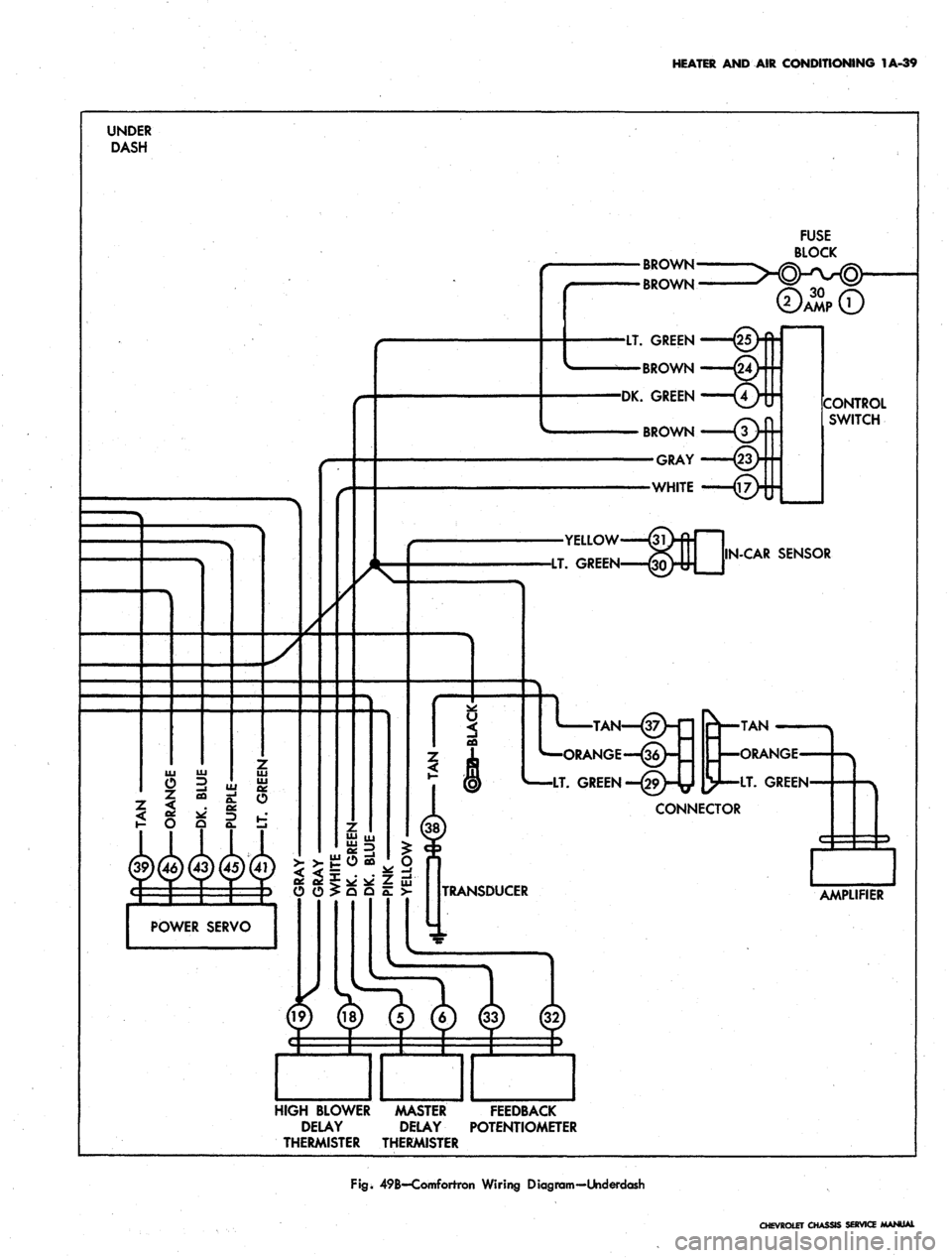
HEATER AND AIR CONDITIONING 1A-39
BROWN
BROWN
LT.
GREEN
BROWN
DK. GREEN
CONTROL
SWITCH
N-CAR
SENSOR
"—ORANGE—(36
[y—LT. GREEN
*)WWWW 55|—jg
TRANSDUCER
POWER SERVO
HIGH BLOWER MASTER FEEDBACK
DELAY DELAY POTENTIOMETER
THERMISTER THERMISTER
Fig.
49B-Comforrron Wiring Diagram-Underdash
CHEVROLET CHASSIS SERVICE AAANUAL
Page 63 of 659

HEATER AND AIR CONDITIONING 1A-40
THERAAAL VACUUM
VALVE
TO ENGINE
VACUUM
SOURCE
VACUUM STORAGE
TANK
OUTSIDE AIR
DIAPHRAGM
MODE
DIAPHRAGM
VACUUM
RELAY
BLACK
DEFOG-DEICE
DIAPHRAGM
GREEN
BLACKj ||
|
BROWN
CONTROL
VALVE
Fig.
50—Comfortron Vacuum Diagram
are fused which will lead to evaporator freeze-up.
Replace the switch.
• If the compressor does not operate regardless of
the position of the knob a loss of the power
element charge is indicated provided that it has
been established that power is supplied to the
switch. This, of course, results in no cooling.
Replace the switch.
• Check the screw threads for stripped or other-
wise damaged threads.
Adjusting Switch
H, after checks above, the switch seems to be operating
properly,
follows:
adjust for proper setting if necessary, as
1.
(Chevy II All-Weather) Turn the outer air deflector
in the face plate so that the attaching screws may
be removed; Then remove the control knobs, bezels
and the thermostatic switch. (Universal) remove the
face plate retaining screws. Pull the faceplate away
from the case when ready to turn the switch adjusting
screw.
2.
Vehicle must be set up as in Step 2 above.
3.
The suction side of the system, read on the low
pressure gauge, should pull down to the pressure
shown in the chart in Performance Test under the
ambient temperature at the time the switch is being
set.
4.
If the low side pulls down lower than the prescribed
pressure at the end of each cooling cycle, turn the
adjusting screw (See Figure 54) clockwise in single
CHEVROLET CHASSIS SERVICE MANUAL
Page 64 of 659
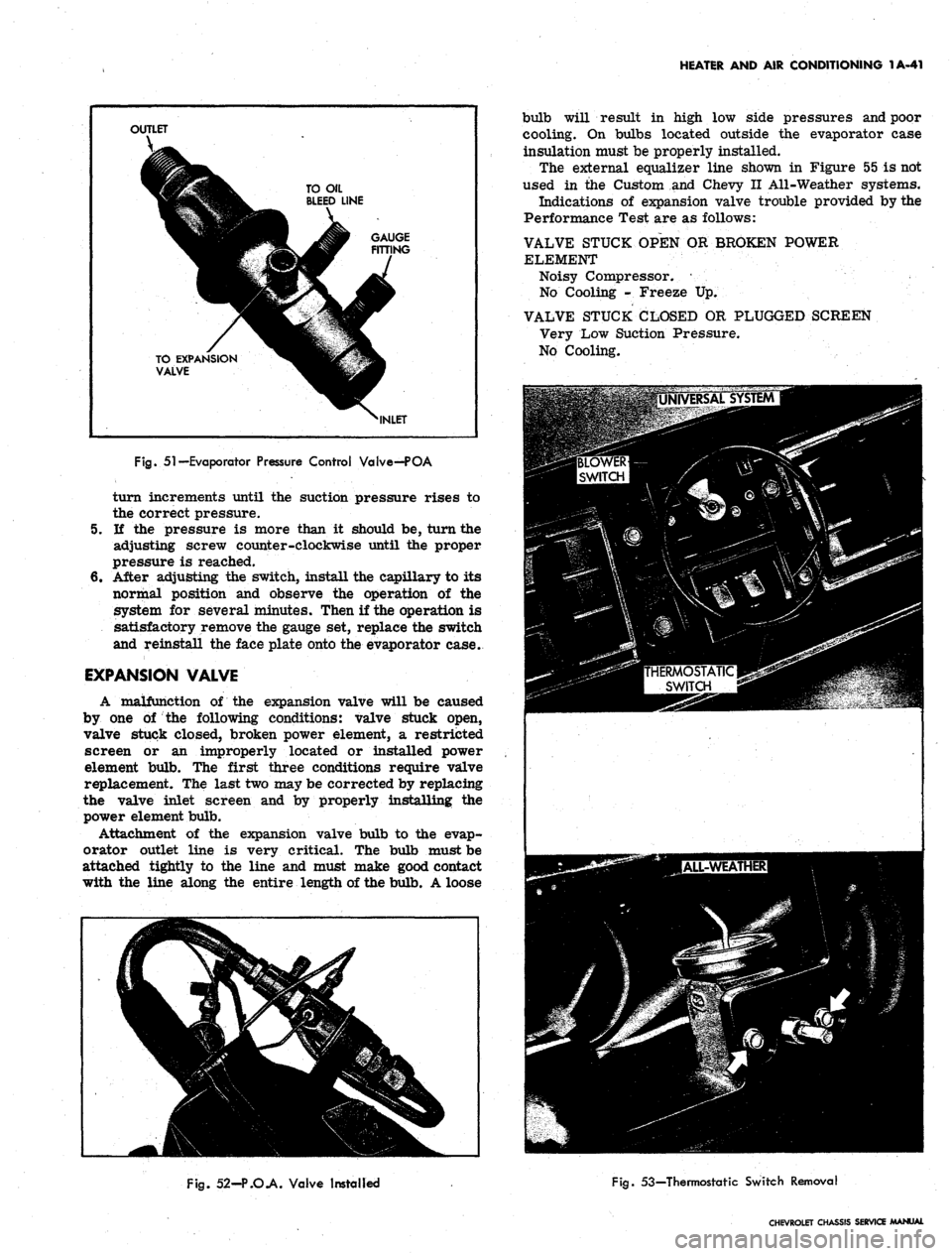
HEATER
AND AIR
CONDITIONING
1A-41
OUTLET
1
TO EXPANSION
^
VALVE
TO
OIL
BLEED LINE
^ INLET
Fig.
51—Evaporator Pressure Control Valve—POA
turn increments until
the
suction pressure rises
to
the correct pressure.
5.
If the
pressure
is
more than
it
should
be,
turn the
adjusting screw counter-clockwise until
the
proper
pressure
is
reached.
6. After adjusting
the
switch, install the capillary to
its
normal position
and
observe
the
operation
of the
system
for
several minutes. Then
if
the operation
is
satisfactory remove the gauge
set,
replace the switch
and reinstall the face plate onto the evaporator case.
EXPANSION VALVE
A malfunction
of the
expansion valve will
be
caused
by
one of the
following conditions: valve stuck open,
valve stuck closed, broken power element,
a
restricted
screen
or an
improperly located
or
installed power
element bulb.
The
first three conditions require valve
replacement.
The
last two may be corrected by replacing
the valve inlet screen
and by
properly installing
the
power element bulb.
Attachment
of the
expansion valve bulb
to the
evap-
orator outlet line
is
very critical.
The
bulb must be
attached tightly
to the
line
and
must make good contact
with
the
line along
the
entire length
of
the bulb. A loose
bulb will result
in
high
low
side pressures and poor
cooling.
On
bulbs located outside
the
evaporator case
insulation must be properly installed.
The external equalizer line shown
in
Figure
55 is
not
used
in the
Custom
and
Chevy
II
All-Weather systems.
Indications
of
expansion valve trouble provided by the
Performance Test are
as
follows:
VALVE STUCK OPEN
OR
BROKEN POWER
ELEMENT
Noisy Compressor.
•
No Cooling
-
Freeze
Up.
VALVE STUCK CLOSED
OR
PLUGGED SCREEN
Very Low Suction Pressure.
No Cooling.
Fig.
52-P.O.A. Valve Installed
Fig.
53—Thermostatic Switch Removal
CHEVROLET CHASSIS SERVICE MANUAL
Page 65 of 659
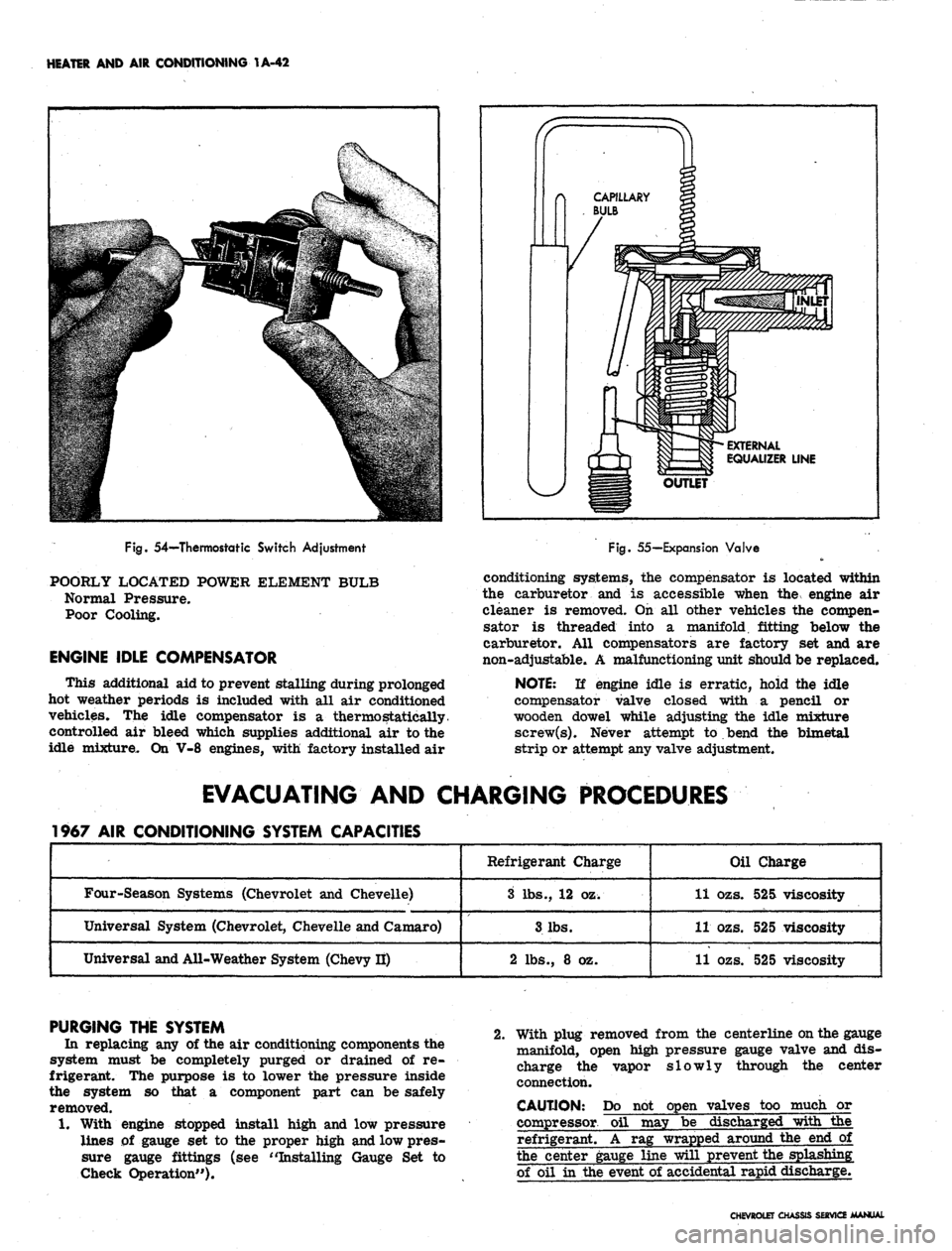
HEATER AND AIR CONDITIONING 1A-42
EXTERNAL
EQUALIZER LINE
Fig. 54—Thermosratic Switch Adjustment
POORLY LOCATED POWER ELEMENT BULB
Normal Pressure.
Poor Cooling.
ENGINE IDLE COMPENSATOR
This additional aid to prevent stalling during prolonged
hot weather periods is included with all air conditioned
vehicles. The idle compensator is a thermostatically
controlled air bleed which supplies additional air to the
idle mixture. On V-8 engines, with factory installed air
Fig. 55—Expansion Valve
conditioning systems, the compensator is located within
the carburetor and is accessible when the engine air
cleaner is removed. On all other vehicles the compen-
sator is threaded into a manifold, fitting below the
carburetor. All compensators are factory set and are
non-adjustable. A malfunctioning unit should be replaced.
NOTE:
If engine idle is erratic, hold the idle
compensator valve closed with a pencil or
wooden dowel while adjusting the idle mixture
screw(s). Never attempt to bend the bimetal
strip or attempt any valve adjustment.
EVACUATING AND CHARGING PROCEDURES
1967 AIR CONDITIONING SYSTEM CAPACITIES
Four-Season Systems (Chevrolet and Chevelle)
Universal System (Chevrolet, Chevelle and Camaro)
Universal and All-Weather System (Chevy II)
Refrigerant Charge
3 lbs., 12 oz.
3 lbs.
2 lbs., 8 oz.
Oil Charge
11 ozs. 525 viscosity
11 ozs. 525 viscosity
11 ozs. 525 viscosity
PURGING THE SYSTEM
In replacing any of the air conditioning components the
system must be completely purged or drained of re-
frigerant. The purpose is to lower the pressure inside
the system so that a component part can be safely
removed.
1.
With engine stopped install high and low pressure
lines of gauge set to the proper high and low pres-
sure gauge fittings (see "Installing Gauge Set to
Check Operation").
2.
With plug removed from the centerline on the gauge
manifold, open high pressure gauge valve and dis-
charge the vapor slowly through the center
connection.
CAUTION: Do
compressor
refrigerant.
not open valves too much or
oil may be discharged with the
A rag wrapped around the end of
the center gauge line will prevent the splashing
of oil in the event of accidental rapid discharge.
CHEVROLET CHASSIS SERVICE MANUAL
Page 66 of 659
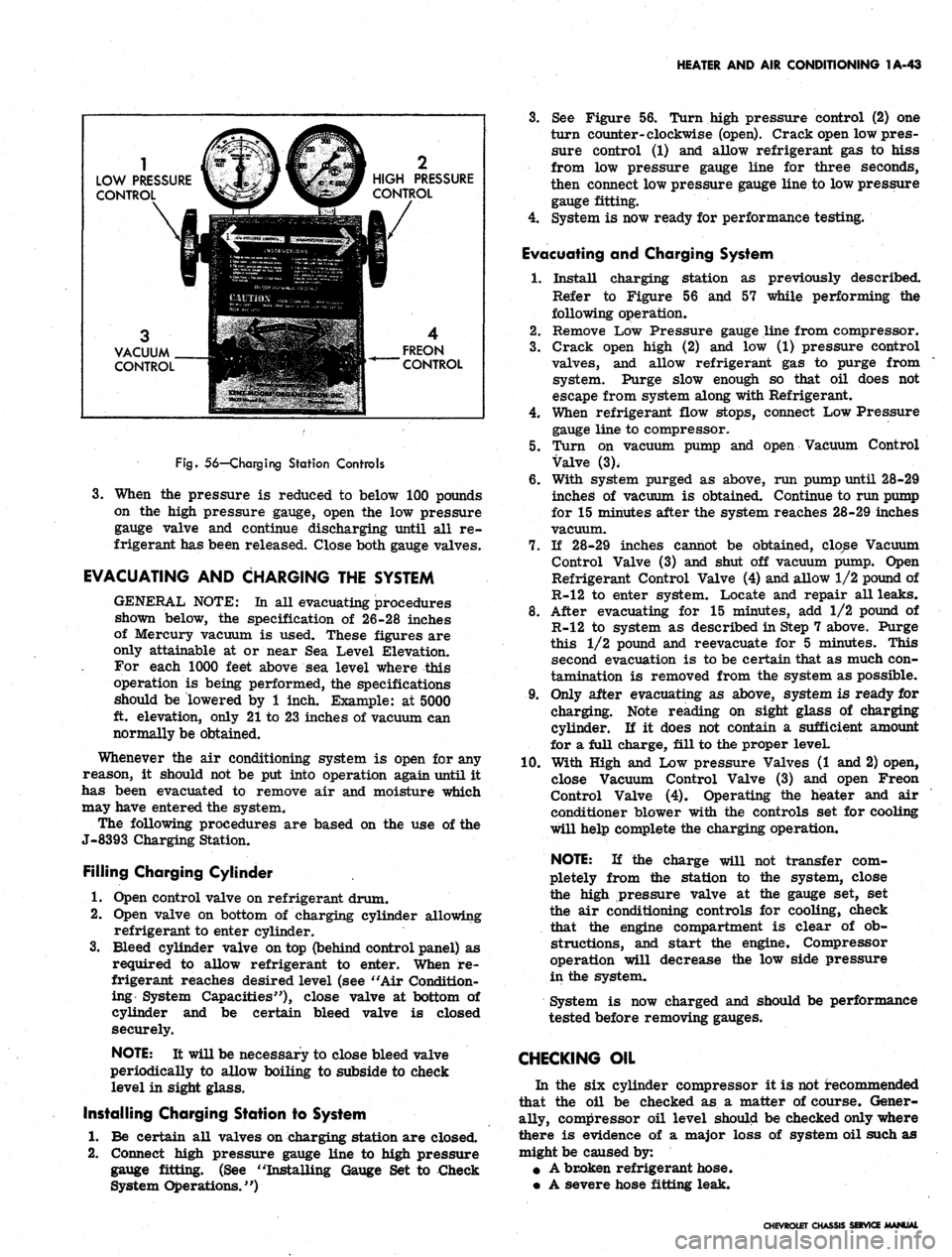
HEATER AND AIR CONDITIONING 1A-43
LOW PRESSURE
CONTROL
HIGH PRESSURE
CONTROL
3
VACUUM
CONTROL
4
FREON
CONTROL
Fig,
56—Charging Station Controls
3.
When the pressure is reduced to below 100 pounds
on the high pressure gauge, open the low pressure
gauge valve and continue discharging until all re-
frigerant has been released. Close both gauge valves.
EVACUATING AND CHARGING THE SYSTEM
GENERAL NOTE: La all evacuating procedures
shown below, the specification of 26-28 inches
of Mercury vacuum is used. These figures are
only attainable at or near Sea Level Elevation.
For each 1000 feet above sea level where this
operation is being performed, the specifications
should be lowered by 1 inch. Example: at 5000
ft. elevation, only 21 to 23 inches of vacuum can
normally be obtained.
Whenever the air conditioning system is open for any
reason, it should not be put into operation again until it
has been evacuated to remove air and moisture which
may have entered the system.
The following procedures are based on the use of the
J-8393 Charging Station.
Filling Charging Cylinder
1.
Open control valve on refrigerant drum.
2.
Open valve on bottom of charging cylinder allowing
refrigerant to enter cylinder.
3.
Bleed cylinder valve on top (behind control panel) as
required to allow refrigerant to enter. When re-
frigerant reaches desired level (see "Air Condition-
ing System Capacities"), close valve at bottom of
cylinder and be certain bleed valve is closed
securely.
NOTE: It will be necessary to close bleed valve
periodically to allow boiling to subside to check
level in sight glass.
Installing Charging Station to System
1.
Be certain all valves on charging station are closed.
2.
Connect high pressure gauge line to high pressure
gauge fitting. (See "Installing Gauge Set to Check
System Operations.")
3.
See Figure 56. Turn high pressure control (2) one
turn counter-clockwise (open). Crack open low pres-
sure control (1) and allow refrigerant gas to hiss
from low pressure gauge line for three seconds,
then connect low pressure gauge line to low pressure
gauge fitting.
4.
System is now ready for performance testing.
Evacuating and Charging System
1.
Install charging station as previously described.
Refer to Figure 56 and 57 while performing the
following operation.
2.
Remove Low Pressure gauge line from compressor.
3.
Crack open high (2) and low (1) pressure control
valves, and allow refrigerant gas to purge from
system. Purge slow enough so that oil does not
escape from system along with Refrigerant.
4.
When refrigerant flow stops, connect Low Pressure
gauge line to compressor.
5.
Turn on vacuum pump and open Vacuum Control
Valve (3).
6. With system purged as above, run pump until 28-29
inched of vacuum is obtained. Continue to run pump
for 15 minutes after the system reaches 28-29 inches
vacuum.
7.
If 28-29 inches cannot be obtained, close Vacuum
Control Valve (3) and shut off vacuum pump. Open
Refrigerant Control Valve (4) and allow 1/2 pound of
R-12 to enter system. Locate and repair all leaks.
8. After evacuating for 15 minutes, add 1/2 pound of
R-12 to system as described in Step 7 above. Purge
this 1/2 pound and reevacuate for 5 minutes. This
second evacuation is to be certain that as much con-
tamination is removed from the system as possible.
9. Only after evacuating as above, system is ready for
charging. Note reading on sight glass of charging
cylinder. If it does not contain a sufficient amount
for a full charge, fill to the proper leveL
10.
With High and Low pressure Valves (1 and 2) open,
close Vacuum Control Valve (3) and open Freon
Control Valve (4). Operating the heater and air
conditioner blower with the controls set for cooling
will help complete the charging operation.
NOTE: If the charge will not transfer com-
pletely from the station to the system, close
the high pressure valve at the gauge set, set
the air conditioning controls for cooling, check
that the engine compartment is clear of ob-
structions, and start the engine. Compressor
operation will decrease the low side pressure
in the system.
System is now charged and should be performance
tested before removing gauges.
CHECKING OIL
In the six cylinder compressor it is not recommended
that the oil be checked as a matter of course. Gener-
ally, compressor oil level should be checked only where
there is evidence of a major loss of system oil such as
might be caused by:
• A broken refrigerant hose.
• A severe hose fitting leak.
CHEVROLET CHASSIS SERVICE MANUAL
Page 67 of 659
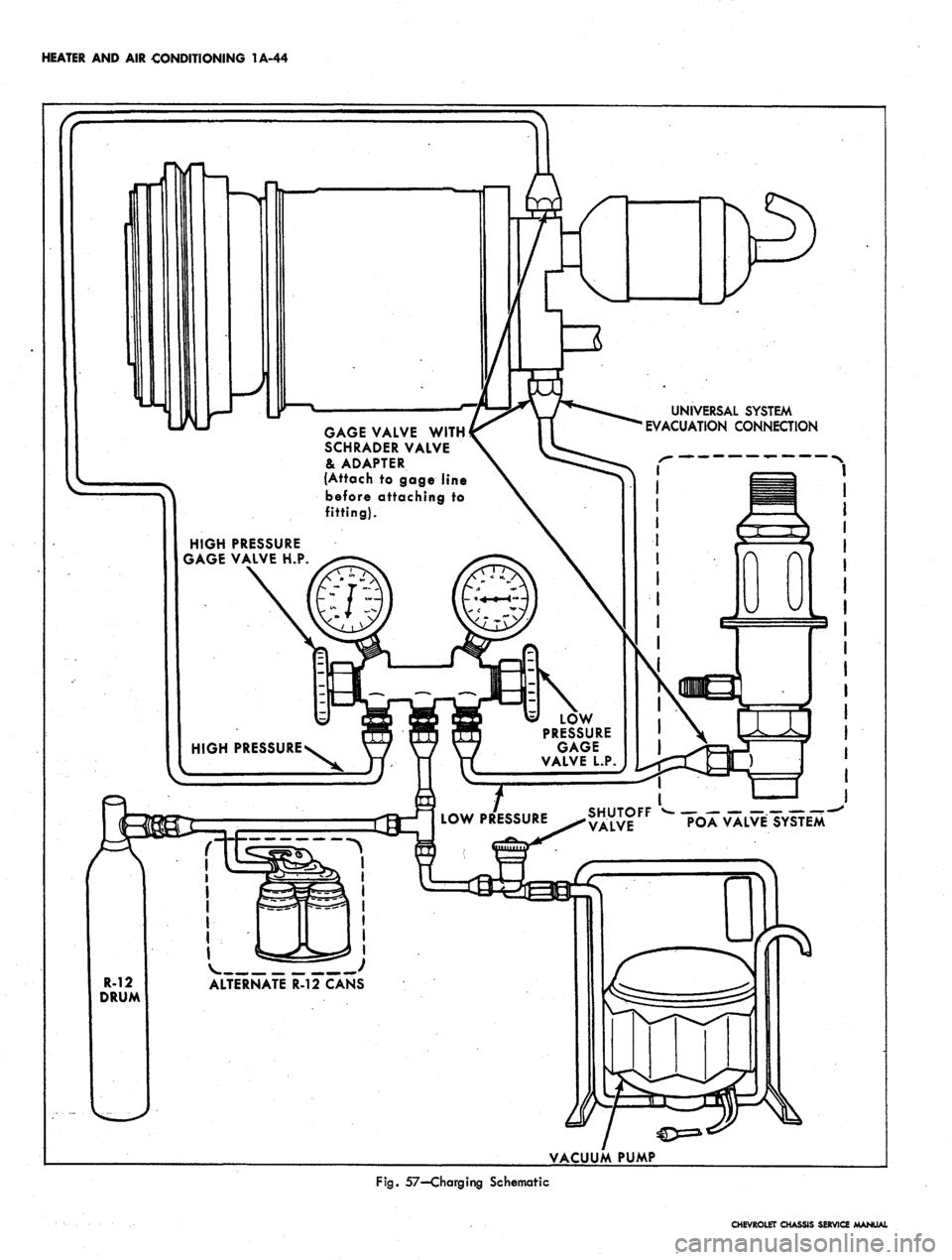
HEATER AND AIR CONDITIONING 1A-44
UNIVERSAL SYSTEM
EVACUATION CONNECTION
GAGE VALVE WITH
SCHRADER VALVE
& ADAPTER
(Attach
to
gage line
before attaching to
fitting).
HIGH PRESSURE
GAGE VALVE H.P.
LOW
PRESSURE
GAGE
VALVE L.P.
LOW PRESSURE
VALVE
POA
VALVE SYSTEM
ALTERNATE R-12 CANS
VACUUM PUMP
Fig.
57—Charging Schematic
CHEVROLET CHASSIS SERVICE MANUAL
Page 68 of 659
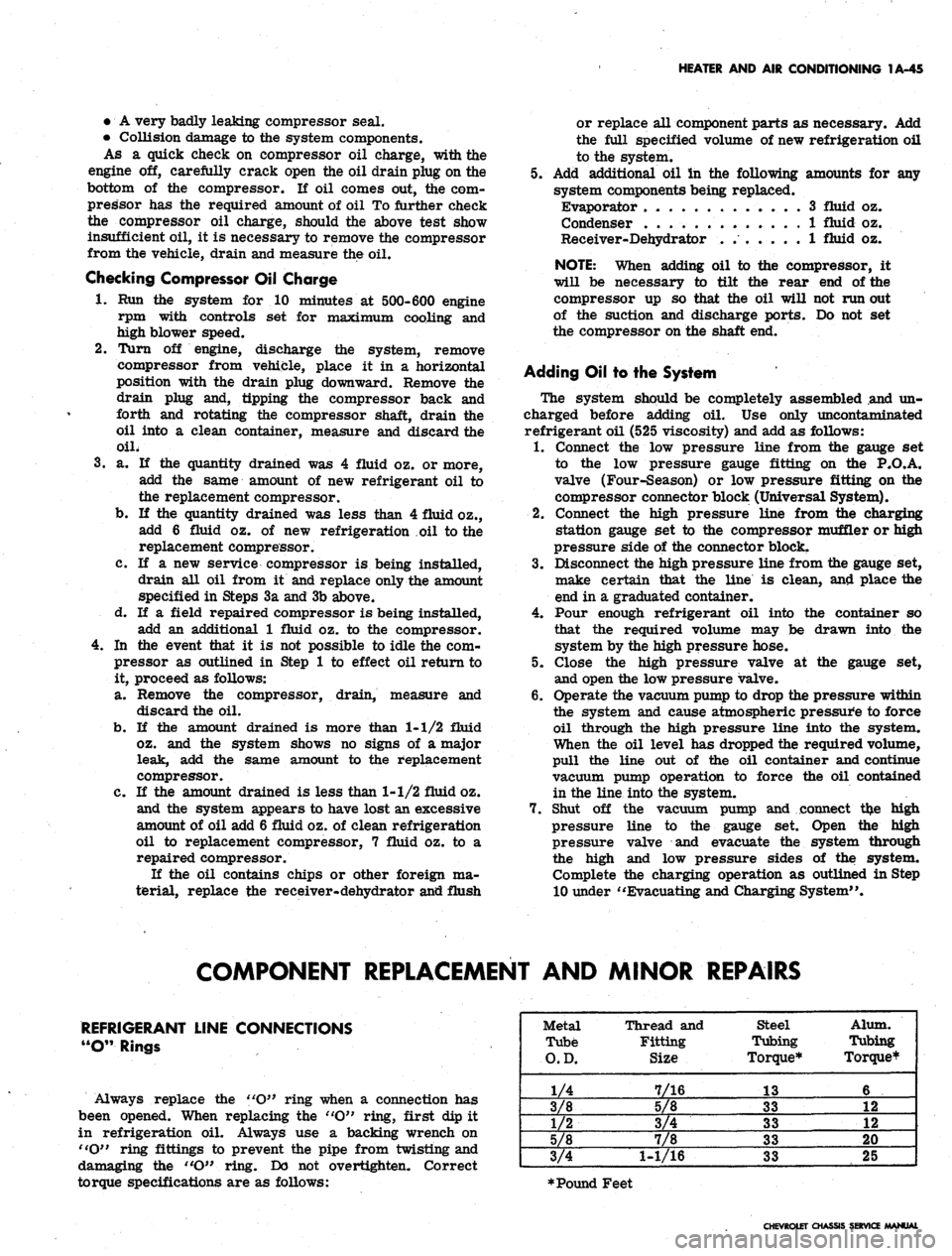
HEATER AND AIR CONDITIONING 1A-45
• A very badly leaking compressor seal.
• Collision damage to the system components.
As a quick check on compressor oil charge, with the
engine off, carefully crack open the oil drain plug on the
bottom of the compressor. If oil comes out, the com-
pressor has the required amount of oil To further check
the compressor oil charge, should the above test show
insufficient oil, it is necessary to remove the compressor
from the vehicle, drain and measure the oil.
Checking Compressor Oil Charge
1.
Run the system for 10 minutes at 500-600 engine
rpm with controls set for maximum cooling and
high blower speed.
2.
Turn off engine, discharge the system, remove
compressor from vehicle, place it in a horizontal
position with the drain plug downward. Remove the
drain plug and, tipping the compressor back and
forth and rotating the compressor shaft, drain the
oil into a clean container, measure and discard the
oiL
3.
a. If the quantity drained was 4 fluid oz. or more,
add the same amount of new refrigerant oil to
the replacement compressor.
b.
If the quantity drained was less than 4 fluid oz.,
add 6 fluid oz. of new refrigeration oil to the
replacement compressor.
c. If a new service compressor is being installed,
drain all oil from it and replace only the amount
specified in Steps 3a and 3b above.
d. If a field repaired compressor is being installed,
add an additional 1 fluid oz. to the compressor.
4.
In the event that it is not possible to idle the com-
pressor as outlined in Step 1 to effect oil return to
it, proceed as follows:
a. Remove the compressor, drain, measure and
discard the oil.
b.
If the amount drained is more than 1-1/2 fluid
oz.
and the system shows no signs of a major
leak, add the same amount to the replacement
compressor.
c. If the amount drained is less than 1-1/2 fluid oz.
and the system appears to have lost an excessive
amount of oil add 6 fluid oz. of clean refrigeration
oil to replacement compressor, 7 fluid oz. to a
repaired compressor.
If the oil contains chips or other foreign ma-
terial, replace the receiver-dehydrator and flush
or replace all component parts as necessary. Add
the full specified volume of new refrigeration oil
to the system.
5.
Add additional oil in the following amounts for any
system components being replaced.
Evaporator 3 fluid oz.
Condenser . . . . ... . . . . . . 1 fluid oz.
Receiver-Dehydrator ....... 1 fluid oz.
NOTE: When adding oil to the compressor, it
will be necessary to tilt the rear end of the
compressor up so that the oil will not run out
of the suction and discharge ports. Do not set
the compressor on the shaft end.
Adding Oil to the System
The system should be completely assembled and un-
charged before adding oil. Use only uncontaminated
refrigerant oil (525 viscosity) and add as follows:
1.
Connect the low pressure line from the gauge set
to the low pressure gauge fitting on the P.O.A.
valve (Four-Season) or low pressure fitting on the
compressor connector Mock (Universal System).
2.
Connect the high pressure line from the charging
station gauge set to the compressor muffler or high
pressure side of the connector block.
3.
Disconnect the high pressure line from the gauge set,
make certain that the line is clean, and place the
end in a graduated container.
4.
Pour enough refrigerant oil into the container so
that the required volume may be drawn into the
system by the high pressure hose.
5.
Close the high pressure valve at the gauge set,
and open the low pressure valve.
6. Operate the vacuum pump to drop the pressure within
the system and cause atmospheric pressure to force
oil through the high pressure line into the system.
When the oil level has dropped the required volume,
pull the line out of the oil container and continue
vacuum pump operation to force the oil contained
in the line into the system.
7.
Shut off the vacuum pump and connect ttye high
pressure line to the gauge set. Open the high
pressure valve and evacuate the system through
the high and low pressure sides of the system.
Complete the charging operation as outlined in Step
10 under "Evacuating and Charging System".
COMPONENT REPLACEMENT AND MINOR REPAIRS
REFRIGERANT LINE CONNECTIONS
"O"
Rings
Always replace the "O" ring when a connection has
been opened. When replacing the "O" ring, first dip it
in refrigeration oil. Always use a backing wrench on
"O"
ring fittings to prevent the pipe from twisting and
damaging the "O" ring. Do not overtighten. Correct
torque specifications are as follows:
Metal
Tube
O.D.
1/4
3/8
1/2
5/8
3/4
Thread and
Fitting
Size
7/16
5/8
3/4
7/8
1-1/16
Steel
Tubing
Torque*
13
33
33
33
33
Alum.
Tubing
Torque*
6
12
12
20
25
* Pound Feet
CHEVROLET CHASSIS SERVICE
Page 69 of 659
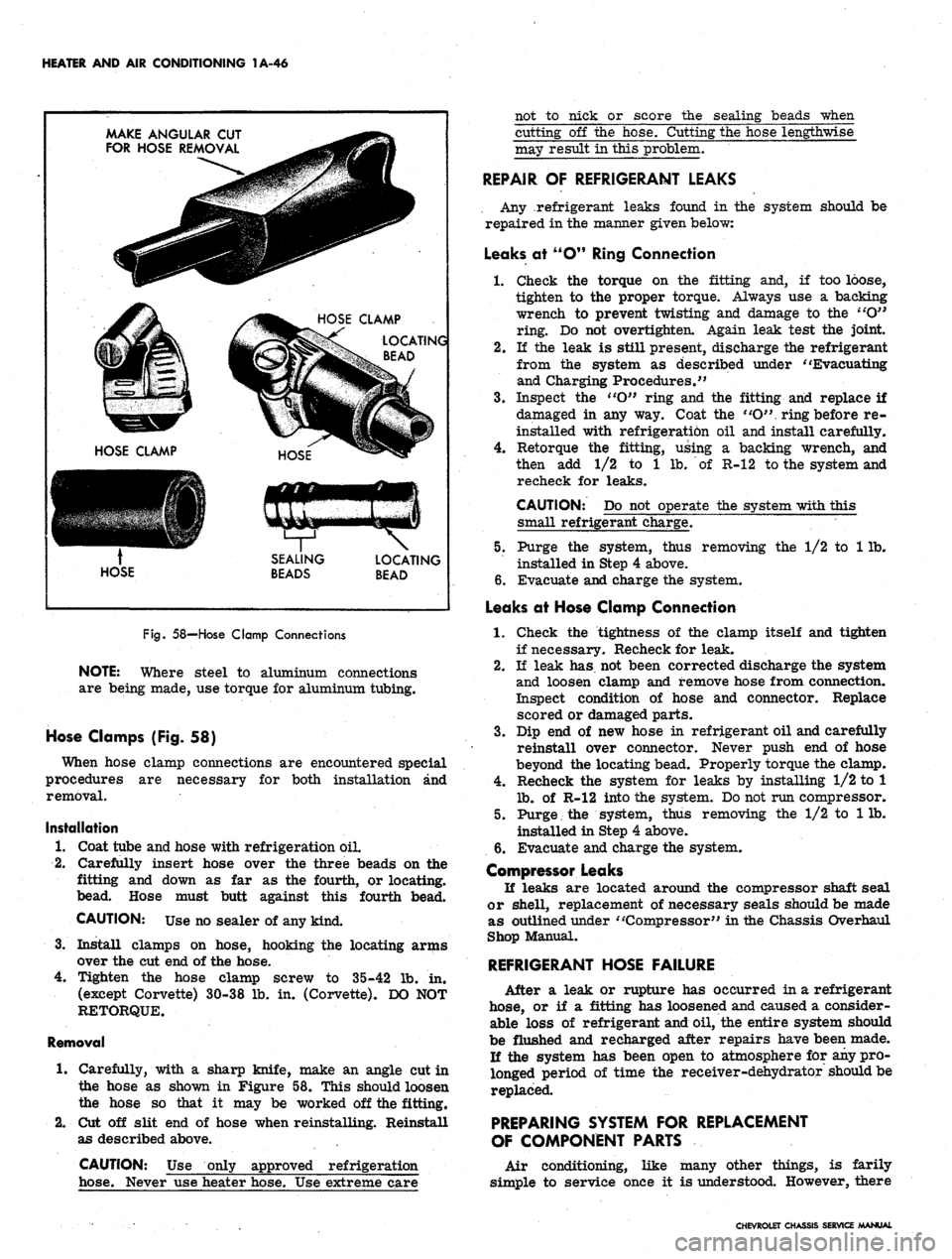
HEATER AND AIR CONDITIONING 1A-46
MAKE ANGULAR CUT
FOR HOSE REMOVAL
LOCATING
BEAD
SEALING
BEADS
LOCATING
BEAD
not to nick or score the sealing beads when
cutting off the hose. Cutting the hose lengthwise
may result in this problem.
Fig.
58—Hose Clamp Connections
NOTE:
Where steel to aluminum connections
are being made, use torque for aluminum tubing.
Hose Clamps (Fig. 58)
When hose clamp connections are encountered special
procedures are necessary for both installation and
removal.
Installation
1.
Coat tube and hose with refrigeration oil.
2.
Carefully insert hose over the three beads on the
fitting and down as far as the fourth, or locating,
bead. Hose must butt against this fourth bead.
CAUTION: Use no sealer of any kind.
3.
Install clamps on hose, hooking the locating arms
over the cut end of the hose.
4.
Tighten the hose clamp screw to 35-42 lb. in.
(except Corvette) 30-38 lb. in. (Corvette). DO NOT
RETORQUE.
Removal
1.
Carefully, with a sharp knife, make an angle cut in
the hose as shown in Figure 58. This should loosen
the hose so that it may be worked off the fitting.
2.
Cut off slit end of hose when reinstalling. Reinstall
as described above.
CAUTION: Use only approved refrigeration
hose. Never use heater hose. Use extreme care
REPAIR OF REFRIGERANT LEAKS
Any refrigerant leaks found in the system should be
repaired in the manner given below:
Leaks at "O" Ring Connection
1.
Check the torque on the fitting and, if too loose,
tighten to the proper torque. Always use a backing
wrench to prevent twisting and damage to the "O"
ring. Do not overtighten. Again leak test the joint.
2.
If the leak is still present, discharge the refrigerant
from the system as described under "Evacuating
and Charging Procedures."
3.
Inspect the ''O" ring and the fitting and replace if
damaged in any way. Coat the "O". ring before re-
installed with refrigerati6n oil and install carefully.
4.
Retorque the fitting, using a backing wrench, and
then add 1/2 to 1 lb. of R-12 to the system and
recheck for leaks.
CAUTION: Do not operate the system with this
small refrigerant charge.
5. Purge the system, thus removing the 1/2 to 1 lb.
installed in Step 4 above.
6. Evacuate and charge the system.
Leaks at Hose Clamp Connection
1.
Check the tightness of the clamp itself and tighten
if necessary. Recheck for leak.
2.
If leak has not been corrected discharge the system
and loosen clamp and remove hose from connection.
Inspect condition of hose and connector. Replace
scored or damaged parts.
3.
Dip end of new hose in refrigerant oil and carefully
reinstall over connector. Never push end of hose
beyond the locating bead. Properly torque the clamp.
4.
Recheck the system for leaks by installing 1/2 to 1
lb.
of R-12 into the system. Do not run compressor.
5. Purge. the system, thus removing the 1/2 to 1 lb.
installed in Step 4 above.
6. Evacuate and charge the system.
Compressor Leaks
If leaks are located around the compressor shaft seal
or shell, replacement of necessary seals should be made
as outlined under "Compressor" in the Chassis Overhaul
Shop Manual.
REFRIGERANT HOSE FAILURE
After a leak or rupture has occurred in a refrigerant
hose, or if a fitting has loosened and caused a consider-
able loss of refrigerant and oil, the entire system should
be flushed and recharged after repairs have been made.
Ji the system has been open to atmosphere for any pro-
longed period of time the receiver-dehydrator should be
replaced.
PREPARING SYSTEM FOR REPLACEMENT
OF COMPONENT PARTS
Air conditioning, like many other things, is farily
simple to service once it is understood. However, there
CHEVROLET CHASSIS SERVICE MANUAL
Page 70 of 659
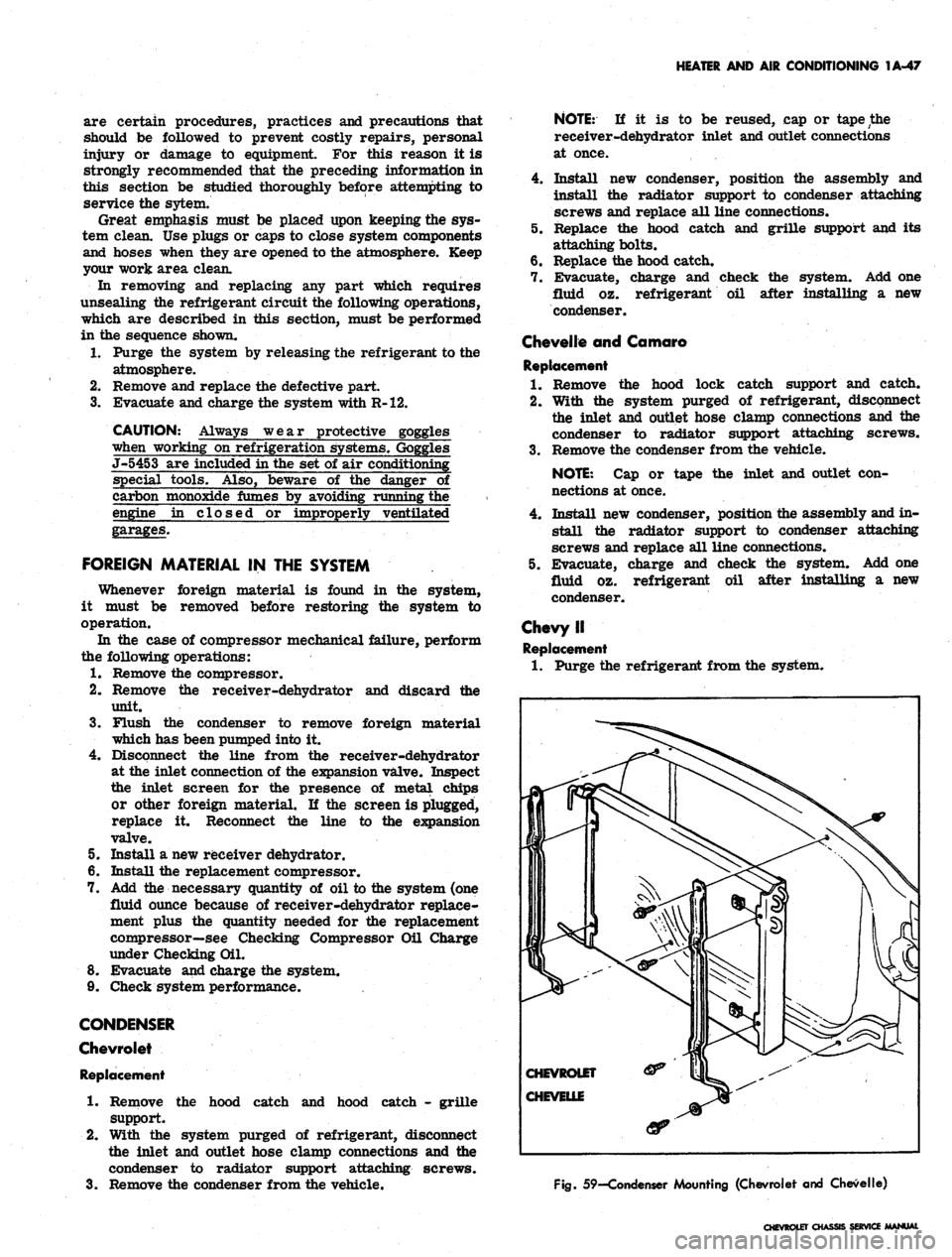
HEATER AND AIR CONDITIONING 1A-47
are certain procedures, practices and precautions that
should be followed to prevent costly repairs, personal
injury or damage to equipment. For this reason it is
strongly recommended that the preceding information in
this section be studied thoroughly before attempting to
service the sytem.
Great emphasis must be placed upon keeping the sys-
tem clean. Use plugs or caps to close system components
and hoses when they are opened to the atmosphere. Keep
your work area clean.
In removing and replacing any part which requires
unsealing the refrigerant circuit the following operations,
which are described in this section, must be performed
in the sequence shown.
1.
Purge the system by releasing the refrigerant to the
atmosphere.
2.
Remove and replace the defective part.
3.
Evacuate and charge the system with R-12.
CAUTION: Always wear protective goggles
when working on refrigeration systems. Goggles
J-5453 are included in the set of air conditioning
special tools. Also, beware of the danger of
carbon monoxide fumes by avoiding running the
engine in closed or improperly ventilated
garages.
FOREIGN MATERIAL IN THE SYSTEM
Whenever foreign material is found in the system,
it must be removed before restoring the system to
operation.
In the case of compressor mechanical failure, perform
the following operations:
1.
Remove the compressor.
2.
Remove the receiver-dehydrator and discard me
unit.
3.
Flush the condenser to remove foreign material
which has been pumped into it.
4.
Disconnect the line from the receiver-dehydrator
at the inlet connection of the expansion valve. Inspect
the inlet screen for the presence of metal chips
or other foreign material. If the screen is plugged,
replace it. Reconnect the line to the expansion
valve.
5. Install a new receiver dehydrator.
6. Install the replacement compressor.
7. Add the necessary quantity of oil to the system (one
fluid ounce because of receiver-dehydrator replace-
ment plus the quantity needed for the replacement
compressor—see Checking Compressor Oil Charge
under Checking Oil.
8. Evacuate and charge the system.
9. Check system performance.
CONDENSER
Chevrolet
Replacement
1.
Remove the hood catch and hood catch - grille
support.
2.
With the system purged of refrigerant, disconnect
the inlet and outlet hose clamp connections and the
condenser to radiator support attaching screws.
3.
Remove the condenser from the vehicle.
NOTE:
If it is to be reused, cap or tape the
receiver-dehydrator inlet and outlet connections
at once.
4.
Install new condenser, position the assembly and
install the radiator support to condenser attaching
screws and replace all line connections.
5. Replace the hood catch and grille support and its
attaching bolts.
6. Replace the hood catch.
7. Evacuate, charge and check the system. Add one
fluid oz. refrigerant oil after installing a new
condenser.
Chevelle and Camaro
Replacement
1.
Remove the hood lock catch support and catch.
2.
With the system purged of refrigerant, disconnect
the inlet and outlet hose clamp connections and the
condenser to radiator support attaching screws.
3.
Remove the condenser from the vehicle.
NOTE:
Cap or tape the inlet and outlet con-
nections at once.
4.
Install new condenser, position the assembly and in-
stall the radiator support to condenser attaching
screws and replace all line connections.
5. Evacuate, charge and check the system. Add one
fluid oz. refrigerant oil after installing a new
condenser.
Chevy II
Replacement
1.
Purge the refrigerant from the system.
Fig.
59—Condenser Mounting (Chevrolet and Chevelle)
CHEVROLET CHASSIS SERVICE MANUAL